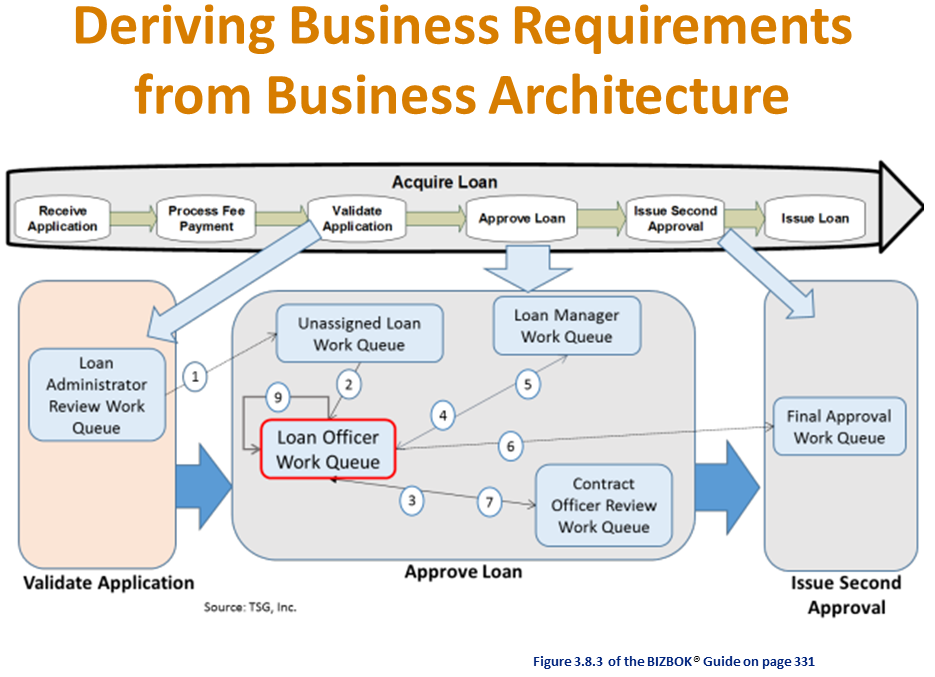
Align Your Requirements to Corporate Strategies Using Business Architecture
In an article entitled “Business Analysts and Business Architecture” published earlier this year in the Business Analyst Times, I got a comment from Duane Banks, a Business Analyst at United. I had shown a graphic were Business Analysts were only involved in some operation planning and mostly in delivery and execution of initiatives. He said the following:

With Business Architecture, Duane and many other Business Analysts are right to assume that the scope of the perspective of a Business Analysts can be much broader than traditionally perceived by the IT industry. With Business Architecture, Business Analysts can now be involved in the strategic, operational and even marketing planning on top delivery and operations of projects, as shown in Figure 1 below.

Business Architecture Propagating Corporate Strategies to IT Professionals
BABOK® Guide v3 is very clear about this. Business Architecture is one of 5 new perspectives that a Business Analyst should take into account while managing its business requirements. In the Business Architecture perspective, reference models are listed instead of methodologies or approaches. They are called meta model, which can include up to 11 different maps, as shown in Figure 2 . No single part of this meta- model should be assessed or altered in complete isolation from the rest of the model.

This diagram takes into account Requirement Mapping and Process Mapping and allows it to be linked to other maps. To execute the business strategies included in business architecture, you need to include requirements and business processes. If the meta model of a corporation’s business architecture is well defined, you can even easily link a requirement among thousands to one or a few processes among again thousands of processes, as in the telco world for example. In brief, a good Business Architecture Model will enable the Business Analysts, the Process Experts and the IT/Software/Enterprise Architects in a large corporation to stop working in silos and start working together, as shown in Figure 3.

Deriving Business Requirements from Business Architecture
Let’s now take a closer look at requirement mapping within Business Architecture and show how both disciplines can work in pair.
Requirements will usually be linked to a value stage and/or capability. In Figure 4 below extracted from the BIZBOK Guide , let’s take a look at this Value Stream, entitled “Acquire Loan”, made of Value Stages in white.

If you take a closer look on how to «Approve a Loan» in this Value Stream, you need to «Validate an Application» beforehand and «Issue a Second Approval» afterward. When you «Approve a Loan», the additional Routing Map or Process Map occurs with 9 steps in this case. It involves stakeholders like the client, the loan administrator, the loan officer, and the contract officer. It also involves the following information concepts: terms of the loan, loan agreement, and minimal monthly minimal payment of loan. It finally involves the “Agreement Structuring” capability and its children “Agreement Terms Management”, which enables the Value Stage “Approve Loan”.
This finally leads to a User Story which could be as short as this one: “As a Loan Officer, I want to set the terms of the agreement to reduce the monthly minimal payment.”

To avoid confusing anyone, Figure 5 shows how a User story could be written using Business Architecture elements that are made available to Business Analysts by Business Architects and their Business Architecture meta model. The user story is longer, but it includes every necessary element of the business architecture. Some of these elements are Capabilities, Information, Stakeholders, a Process, and Values. The count is 14 elements, but it could have been higher if Figure 5 had included the one or two software application(s) in the Asset map that would need to be modified to fulfill this requirement. Finally, it could also have included specific elements of the Strategy Map.
Impacts of Business Architecture on Business Analysts
As you can see, Business Architecture is not just hype. It can assist the Business Analysts in its daily work as shown in this example. There are at least 4 impacts of Business Architecture on Business Analysts:
- Business Architecture enables to build more relevant user stories and business cases using appropriate business strategies and precise vocabulary before they get approved and funded as a project,
- Business Architecture enables clearer requirements definition and requirements validation,
- Business Architecture enables to scope, frame and categorize requirements based on business strategies, and
- Business Architecture avoids requirement duplications across business units and departments.
- Article entitled “Business Analysts and Business Architecture” written by Daniel Lambert and published in Business Analyst Times on March 16, 2015.
- BABOK® Guide v3 is available here for IIBA members.
- Figure 2 is extracted from the LinkedIn article “Increase your Transformation Success Rate with Business Architecture” written by Daniel Lambert published on LinkedIn on April 21, 2015.
- Figure 4 in this article is Figure 3.8.3 extracted from the BIZBOK® Guide on page 331. To access the BIZBOK® Guide, you need to become a member of the Business Architecture Guild.